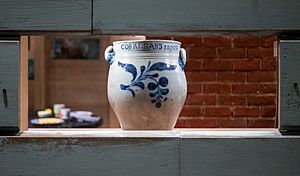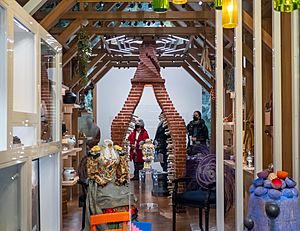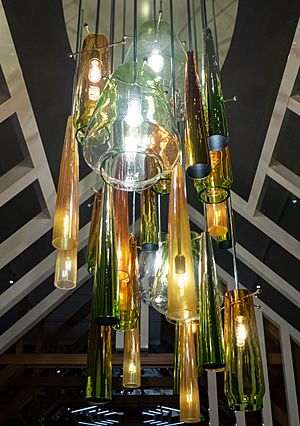Before Yesterday We Could Fly facts for kids
Before Yesterday We Could Fly: An Afrofuturist Period Room is a special art show at the Metropolitan Museum of Art in New York City. It opened on November 5, 2021. This exhibit uses a unique "period room" style. It imagines the home of someone from Seneca Village in the past, present, and future. Seneca Village was a community of mostly African Americans that was destroyed to build Central Park in the 1800s.
Contents
What is a Period Room?
A period room is a museum display that shows what a room from a certain time and place might have looked like. It includes art, furniture, and other items from that era. Before Yesterday We Could Fly asks what a period room could be if it wasn't just about the past. It also looks at the present and future.
Some people have criticized traditional period rooms. They often show perfect, wealthy homes, mostly from European cultures. This exhibit challenges that idea.
The Story of Seneca Village
The exhibit focuses on Seneca Village. This was a 19th-century settlement in Manhattan, New York City. Most of its residents were African American landowners. In 1857, city officials forced people out to build Central Park. The Met museum is located just east of where Seneca Village once stood.
The exhibit recreates a fictional Seneca Village house. It shows how it might have looked then. But it also imagines how descendants of those residents might live today or in the future. This is as if the village had never been destroyed.
What is Afrofuturism?
The future parts of the exhibit are inspired by Afrofuturism. This is an art style and way of thinking. It explores possible futures through the experiences of people of African descent. It often includes themes like imagination, technology, and freedom.
Because not many records or items from Seneca Village remain, even the past parts of the exhibit needed some creative imagination.
Inside the Exhibit
The room is on the first floor of the museum. It looks like a typical 19th-century house with wooden siding. It has an open kitchen with a fireplace and a living room with a television. Visitors can walk around the room and look inside through openings. The kitchen area mostly has older objects and art. The living room looks more towards the future.
The exhibit was put together by Oscar-winning production designer Hannah Beachler. She worked with Met curators Ian Alteveer and Sarah Lawrence. Michelle D. Commander was a consulting director. The exhibit's name, Before Yesterday We Could Fly, comes from an old legend. It's about flying Africans who could escape slavery by flying home. This specific story is from Virginia Hamilton's book The People Could Fly.
Hannah Beachler wanted visitors to first see "pride and joy" in the exhibit. Then, they could explore the deeper, more serious themes. The exhibit is planned to run for at least two years. It is one of several new exhibits the Met is planning about race and social justice.
Art and Artists in the Exhibit

The exhibit uses items from the Met's existing collections, some from as early as the 1600s. It also includes new art from artists like Ini Archibong, Cyrus Kabiru, Roberto Lugo, Zizipho Poswa, and Tourmaline. Three special artworks were created just for this show by Njideka Akunyili Crosby, Fabiola Jean-Louis, and Jenn Nkiru.
Some everyday objects from the Met's collection were chosen because they are similar to items found during the 2011 Seneca Village Project. In total, there are 74 artworks in the exhibit, plus architectural parts and many books.
Many people have praised the inkjet-printed wallpaper by Njideka Akunyili Crosby. It's called "Thriving and Potential, Displaced (Again and Again and…)." Another highlight is a five-sided television designed by Hannah Beachler. It shows a film by Jenn Nkiru called "OUT/ SIDE OF TIME."
A paper dress called "Justice of Ezili" by Fabiola Jean-Louis also stands out. It combines different times and objects. The "Mido Chair" by Jomo Tariku is another striking piece. It reminds visitors of a 19th-century rubber comb also on display. This older comb has a chain-like border. This reminds us of the dangers faced by free Black people after the Fugitive Slave Act of 1850 was passed.
Other artists in the exhibit include Willie Cole, Elizabeth Catlett, and Lorna Simpson.
Roberto Lugo created a vase called Digable Underground. It features images of Harriet Tubman and Erykah Badu. It also has gold roses and Pan-African colors (black, gold, and red). The queer artist Tourmaline has a self-portrait called Morning Cloak, 2020. It explores who should be shown in art, especially in Black portraiture.
Ini Archibong's Vernus 3 is a piece inspired by glass items found during the 2011 excavation. Made of glass and steel, it's a futuristic chandelier with orange and yellow colors. You can see Vernus 3 in the living room, which represents the future. It adds a warm feeling to the space.
More of Archibong's work is throughout the futuristic part of the room. A pair of Atlas Chairs with an African-inspired pattern surround the Orion Table. Both pieces use bright colors and create a lounge area in the living room.





